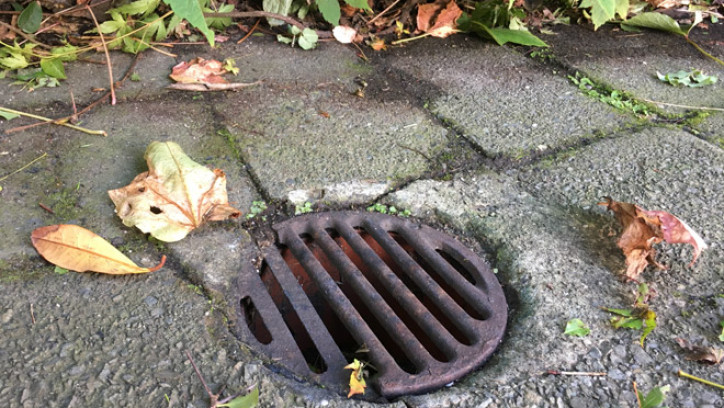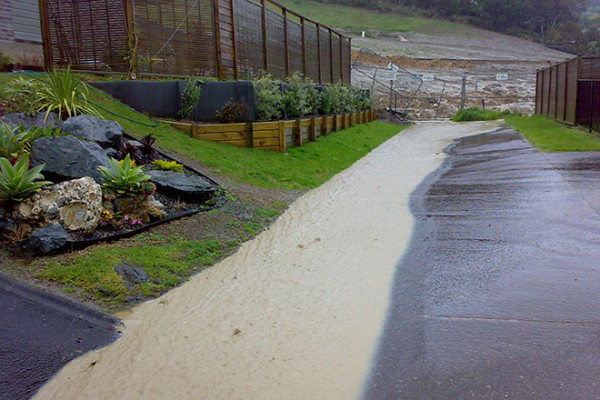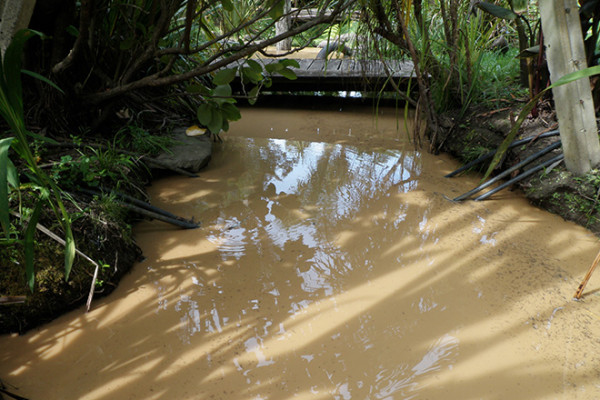Managing stormwater
Last updated: 9 August 2023

Poorly managed stormwater can damage your property and the wider environment. Managed properly, it can be good for your garden.
Managing stormwater
Stormwater is the water that runs off impervious (water resistant) surfaces such as roofs, roads, driveways and footpaths. In urban areas, runoff goes down drains into stormwater pipes or channels and is carried to rivers, lakes or the sea.
On private property, stormwater is the responsibility of the property owner. When it's not properly managed, it can cause flooding, erosion and pollution of waterways. Properly managed, it can help keep your garden lush.
Why does stormwater matter?
Flooding and erosion
If the stormwater pipes in your area are overloaded or blocked, your property and neighbouring properties may be at risk of flooding. Excess stormwater can also cause erosion and a damp home.
Cost
Managing stormwater is costly. City stormwater networks cost many millions of dollars each year to operate and maintain. Millions more are spent on upgrades and additions to the stormwater network. You pay for this through your rates or water charges. The better you can manage stormwater on your property and reduce the run off, the less the council has to spend upgrading facilities, which will save you in the long run.
Pollution
In most areas of New Zealand, stormwater is not treated before it is discharged. This means there are several reasons to be concerned about the way stormwater is managed.
Stormwater from your property flows through underground pipes to streams and the sea. It matters what you put down the drain.
Stormwater isn't pure water. Along the way to its outfall it picks up rubbish, oil, sediment, animal droppings, chemicals, plant nutrients and other contaminants. It can also be contaminated with paint, detergents and anything else people tip down stormwater drains.
These contaminants can do serious harm. High levels of plant nutrients in water can be harmful or fatal to fish and animals. Increased nutrients can cause phytoplankton blooms, which in turn produce biotoxins that affect shellfish and make them unsafe to eat, for example, causing paralytic shellfish poisoning.
In addition, stormwater overflowing from overloaded or blocked drains can find its way into the sewerage system. This can result in sewage backflow entering stormwater pipes and being carried to the sea, lakes or rivers, or back onto residential sections.
Benefits of taking action
By taking steps to improve the way stormwater is managed, you will:
- help to keep rivers, lakes and beaches cleaner and safer for swimming, fishing and other recreational activities
- reduce the risk of flooding and erosion on your property and around your neighbourhood
- reduce the need for spending on stormwater infrastructure, leaving money available for other uses or for savings on your rates bills.
Collecting and using rainwater has more information.
Keeping contaminants out
It matters what you put down the drain.

Poor site controls can result in clay running off a site to the road and down a drain and straight into our local streams.

There are several easy ways to reduce the levels of contaminants that get into the stormwater system:
- Pick up litter before it can wash into drains.
- Clean your car on the lawn using biodegradable detergent or, even better, take it to a car wash that recycles water and detergent.
- Sweep up leaves and grass clippings and put them on the garden or in the compost instead of hosing them down the drain.
- Pick up your dog's droppings.
- Never tip paint, oil, thinners, insecticides or other contaminants down a stormwater drain (or any drain). Contact your landfill or paint shop about disposing of leftover paint, or give it to someone else.
Clean paint brushes in an old container or bucket. Leave the liquid in a safe place for 24 hours to let the paint solids settle to the bottom, then if it's water-based paint, pour off the liquid on top onto the garden (away from vegetables and drains). If you're using solvent-based paint and white spirits, use as little spirits as possible, and after 24 hours decant off the white spirits to reuse later. Dispose of the paint solids in the rubbish. - Shovel up soil, cement and other debris when you're building or landscaping. If possible keep it dry and dispose of it at the landfill.
Managing stormwater with landscaping
Smart home design and landscaping can reduce the amount of stormwater and contaminants entering the stormwater system.
Keep the amount of concrete and paving to a minimum
Water runs off hard surfaces and ends up in the stormwater system.
Consider:
- minimising the amount of hard paving on your property, for example, keep your driveway short by having the garage near the front of the property
- using lawn, decking and semi-porous paving such as stones instead of hard paving or concrete
- using grass or bark mulch strips alongside hard surfaces to absorb runoff
- diverting stormwater from paths and other hard surfaces onto free draining garden areas
- using swales to collect and drain water in low areas of your garden.
Install a rain garden, pumice wick or swale
A rain garden is an attractive and effective way of slowing stormwater flow. Water is filtered and absorbed as it slowly makes its way through layers of soil and mulch. Moisture-loving plants (like native flaxes and grasses) thrive in rain gardens.
A pumice wick is made up of layers of pumice, newspaper or porous mesh, and dirt. Water directed into the wick slowly filters down and along it – sometimes to a deep gravel-filled hole that water can be recycled from, sometimes to a rain garden or swale.
A swale is a wide, gently sloping, vegetated channel that captures water, allowing it to filter into the soil. Choose tough plants that can cope with dry periods and the ground being saturated. Native plants such as manuka, carex grasses, flaxes and hebes are excellent choices for planting in a swale.
For advice on creating rain gardens, pumice wicks and swales, ask your local or regional council, or local garden centre.
Note: Pumice wicks, swales, rain gardens or any other work that requires landscaping or earthworks over a certain size may require resource consent, or may conflict with local drainage bylaws or policies. An engineer's report may be needed as part of the resource consent process. Check with your local council before starting work.
When you're carrying out work, ensure soil and sediment remain on your property – you're liable for any damage to neighbouring sites or pollution of nearby waterways.
Minimise site disturbance
If you're building or renovating, clearing a site or significantly altering the landscape can change the amount and direction of stormwater runoff, and increase the amount of sediment that gets into the stormwater system.
By leaving land and vegetation as untouched as possible, you're less likely to have problems with flooding and erosion.
Collecting and using rainwater
Rainwater can be collected and used on your garden and for other household uses such as washing your clothes and flushing the toilet. The more rainwater you collect, store and use, the less will end up in the stormwater system.
Collecting and using rainwater has more information